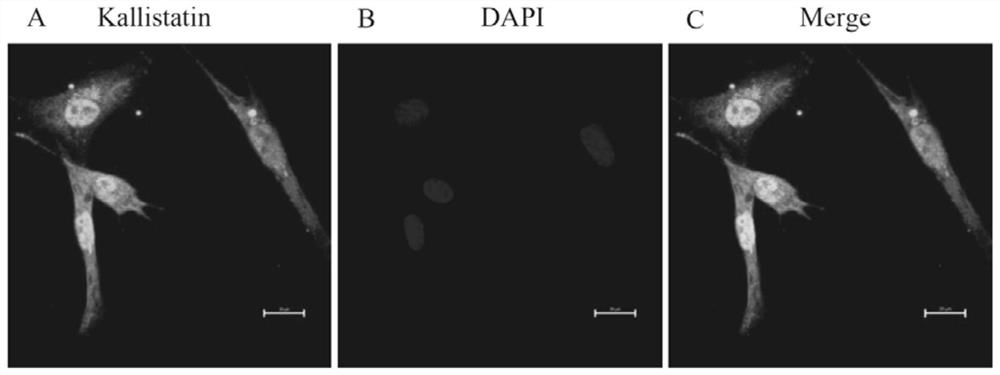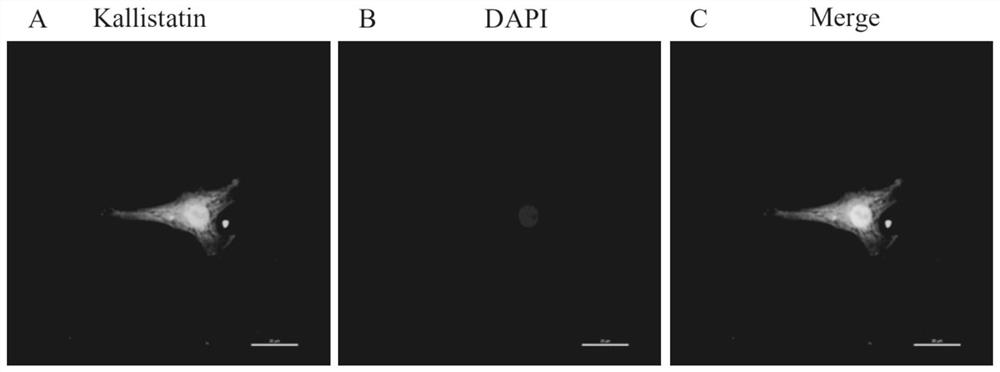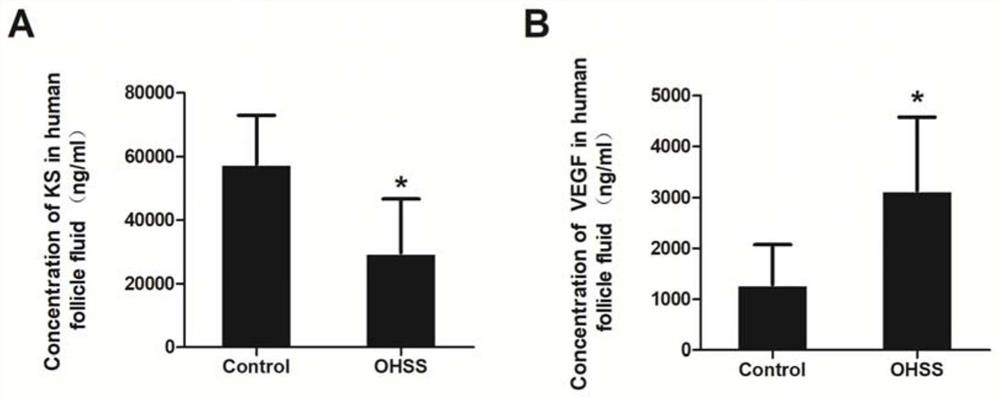Diagnosis marker kallistatin for ovarian hyperstimulation syndrome and its application
A marker and syndrome technology, applied in the field of biotechnology and medical testing, can solve problems such as insufficient ovarian hyperstimulation syndrome
- Summary
- Abstract
- Description
- Claims
- Application Information
AI Technical Summary
Problems solved by technology
Method used
Image
Examples
Embodiment 1
[0031] Example 1Kallistatin protein is widely expressed in ovarian granulosa cells
[0032] This example detects the expression of Kallistatin protein in granulosa cell line KGN and primary ovarian granulosa cells.
[0033]1. Expression of Kallistatin in granulosa cell line KGN cells
[0034] The granulosa cell line KGN cells were cultured, and the expression of Kallistatin factor in the cells was detected by immunofluorescence method.
[0035] (1) Culture of KGN cells
[0036] Take DMEM / F12 medium, add FBS (10%) and penicillin / streptomycin double antibody (1%) to prepare cell culture medium, culture cells in a 100mm cell culture dish, and change the medium every other day until the cell density reaches 80% Cells were passaged at left and right.
[0037] (2) Cell immunofluorescence detection
[0038] 1) Digest and centrifuge the cells with a degree of confluence of about 70%, resuspend with 3ml of cell culture medium, add about 250ul of cell suspension to a small dish of l...
Embodiment 2
[0063] Example 2 Expression of Kallistatin protein in clinical samples of high-risk OHSS and assisted reproduction control patients
[0064] This example studies the expression of Kallistatin protein in the follicular fluid and serum of OHSS high-risk group and control group patients undergoing assisted reproduction.
[0065] On the basis of the informed consent of the patients and the consent of the hospital ethics committee, patients were selected for in vitro fertilization / intracytoplasmic sperm injection-embryo transfer (IVF) in the reproductive center of the Third Affiliated Hospital of Guangzhou Medical University from March 2016 to August 2016. / ICSI-ET) assisted infertility female patients, collect follicular fluid and / or blood samples on the day of egg retrieval, and / or extract granulosa cells from the follicular fluid for experiments. Patients were divided into two groups: OHSS high-risk group and control group according to their general characteristics such as age, ...
Embodiment 3
[0104] Example 3 Expression of Kallistatin gene in clinical samples of high-risk OHSS and assisted reproduction control patients
[0105] This example studies the expression of Kallistatin gene in the follicular fluid of OHSS high-risk group and control group patients undergoing assisted reproduction.
[0106] 1. RNA extraction: Extract the total RNA from the follicular fluid of the control group patients with high risk of OHSS and assisted reproduction. Collect an appropriate amount of follicular fluid from the patient on the day of egg retrieval, centrifuge at 1500-1800rpm at 4°C for 15min, and pipette 1ml of supernatant into two 2ml EP tubes, and mark the patient's name, group and other information on the tube wall. Store in -80°C refrigerator. Add an appropriate amount of Trizol, repeatedly pipetting to lyse the cells, and then transfer into an RNase-free EP tube; if it is tissue, use a mortar to grind the tissue, then add an appropriate amount of Trizol, and repeatedly p...
PUM
| Property | Measurement | Unit |
|---|---|---|
| Sensitivity | aaaaa | aaaaa |
Abstract
Description
Claims
Application Information
 Login to View More
Login to View More - R&D
- Intellectual Property
- Life Sciences
- Materials
- Tech Scout
- Unparalleled Data Quality
- Higher Quality Content
- 60% Fewer Hallucinations
Browse by: Latest US Patents, China's latest patents, Technical Efficacy Thesaurus, Application Domain, Technology Topic, Popular Technical Reports.
© 2025 PatSnap. All rights reserved.Legal|Privacy policy|Modern Slavery Act Transparency Statement|Sitemap|About US| Contact US: help@patsnap.com



